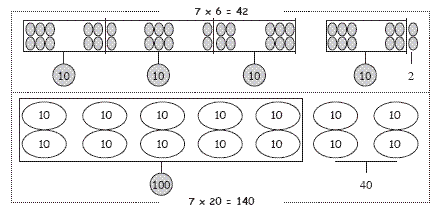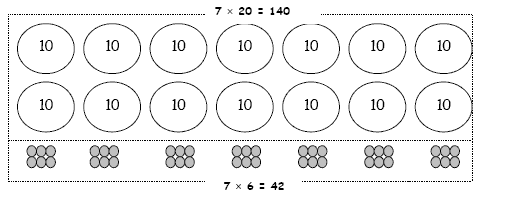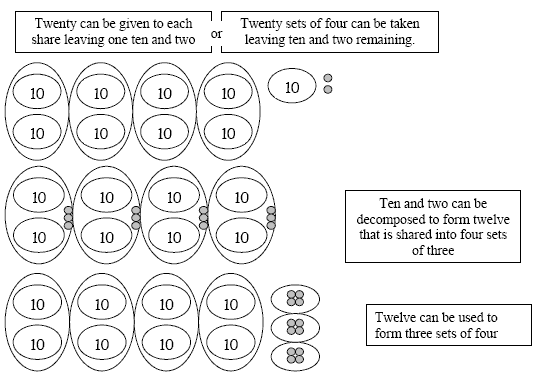Solve multiplication and division problems by using tidy numbers.
Number Framework Stage 7
Using Materials
Tell the students that, before they model with materials, you are going to work out the answer to a simpler multiplication, 7 x 26, by recording it on paper. Use the vertical form and talk through the procedures as you carry them out.
Provide the students with place value materials and ask them to explain how thewritten method works. Discuss what actions are performed on the materials to matchthe notation of the written form. Look to see that students understand that place value partitioning is used to solve 7 x 26:

Ones from the product of 7 × 6 = 42 are used to form four tens that can be added to the product of 7 × 20 = 140. Ask the students to model other examples of the written form with equipment until they show understanding of the process. Keep the number size low enough to enable easy modelling with the materials. Examples might be:
37 × 4 = 148 23 × 8 = 184 69 × 3 = 207
Provide a similar experience for the division written form using the problem 92 ÷ 4.
"Fours into ninety are twenty with one ten remaining."
"Fours into 12 are three."
Provide students with place value materials and ask them to explain what is occurring with the equipment at each stage of the written calculation. Look for the understanding that one set of ten is decomposed into ten singles. The problem can be interpreted as both sharing (partitive division), or, “how many sets of” (quotative division).
Provide other division problems for students to solve using the written form. Use place value materials to illustrate what is happening to the numbers as the recording progresses. Examples might be:
78 ÷ 3 = 26 85 ÷ 5 = 17 102 ÷ 6 = 17 198 ÷ 9 = 22
Using Imaging
Shielding: Provide examples of multiplication and division problems for students to solve using written forms. Create the model of each problem but mask the materials with ice cream containers. Use post-its to label each container so students do not lose track of the numbers involve For example, model 7 x 26 as
Model 48 ÷ 3 as :
Progress to drawing diagrams of the numbers using symbols such as
To represent hundreds, tens, and ones respectively. This representation becomes more useful than manipulating the materials as number size increases.
Examples might be:
Using Number Properties
Increase the number size so students are required to generalise the actions involved in each written form. Examples might be:








